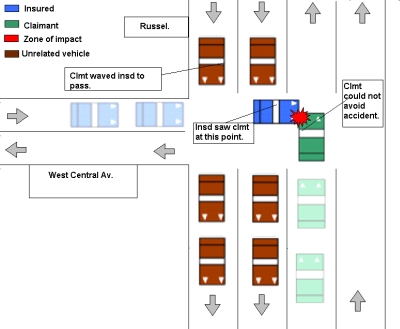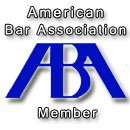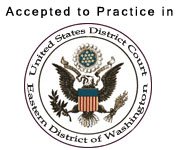Car Driving Tips
Tips 6 to 10
Car Driving Tip # 6: Pay attention to the road ahead (and behind).
Look. We mean it. It’s amazing how in many accidents people will claim that they looked both in directions, behind, on top, in the mirrors, and every possible angle, then pulled out and the other car was “just” there.
A judge, a jury, a claim adjuster, or whoever listens to your argument will tell you that if you looked then you must have seen the big object “called automobile” coming towards you.
I know, this argument is meant to imply that they looked and the vehicle was not there. The only way that could have happened is if the other car was speeding. This is a losing argument. No car can possibly move that fast that it could fool the human eye.
There are three reasons why you would not see a car approaching:
- You did not look,
- You did look but were not paying attention, or
- You looked but you are blind.
Probably option #2 takes the cake for most accidents. Pay attention when you drive.
Car Driving Tip # 7: If they are in the middle of the road – Stop or do something!
You have seen the elements of negligence. Duty is the first element.
All states in the U.S. put an affirmative duty on the driver to avoid an accident. If you see a vehicle illegally parked in the middle of the road, you cannot simply plow into it.
You must try to do everything in your power to avoid the accident.
It does not matter that the other person is grossly negligent. If you fail to try to avoid a car accident, you can be held liable for the damages.
In states that follow a contributory negligence analysis, you would be completely barred from recovering for your damages.
Be extra careful around parks, schools, pedestrian crossings and any other place where things or people can come into the road.
Many drivers give recorded statements and when they are asked what they did to avoid the accident, they answer - Nothing.
They say things like, “He just pulled in front of me and I just hit him. I did not do anything to avoid it”.
I understand that this statement might honestly be implying that there was no time to react.
There was no way a driver could have an immediate reaction to avoid a collision. However, the insurance company will not make any implications for you. You must actually tell them that you tried to avoid the accident but were unable to do so.
Not taking an evasive action could be as bad as not disclosing that you took an evasive action, even if you did.
Car Driving Tip # 8: The vehicle to your right has the right of way
Open intersection accidents occur everyday.
All states have statutes explaining who has the right of way in situations like this one.
They explain that if two vehicles approach an uncontrolled intersection, the vehicle to the right should always yield the right of way.
If an accident occurs, it means that both vehicles approached the intersection about the same time. The vehicle to the left would probably end up paying for all damages and injuries.
When approaching an intersection with not traffic signs, you must slow down substantially to ensure that no vehicle is coming.
If a vehicle is coming on to your right side, then they have the right of way. If there are only vehicles to the left, then you have the right of way.
However, most people slow down and then speed up all of a sudden. If you see a vehicle to your left, still stop and see what they are going to do.
Many drivers will assume that they have the right of way. It’s always a good idea to double check what other drivers will do in that situation. So for car driving tip #8, be sure to know your state's traffic laws.
Car Driving Tip #9: Be careful with the Courtesy Waive – If you get in an accident, it will be your fault!
This accident is extremely common.
You know, it is when the two rows of traffic are going bumper to bumper. You are pulling out of a parking lot or the side street and the vehicle waiting on traffic waves you in.
You tried to cross but the vehicle that is in the second lane does not see you and a collision ensues (see diagram).

Unfortunately, since you are the one going into incoming traffic, that person has the right of way. It does not matter that someone waved you in.
They are not a traffic authority to give you the go ahead.
I never take the courtesy wave when driving. I smile, and say thank you and look more concerned with the other lane than actually taking that type of gamble.
People are trying to be nice, but I rather be rude than get into an accident. So the next time someone gives you the courtesy wave, then simply wave back.
Car Driving Tip # 10: Parking lot accidents keep body shops in business
Parking lot accidents are very common.
To make matters worse, the police department usually does not respond because they do not have jurisdiction over private property (unless there are injuries).
Parking lots are traps for the unwary. It does not matter if you are the most experienced driver in your city and you make every stop, signal every corner, and follow every available traffic sign.
There will be someone not paying attention and will be ready to hit you.
Drive very carefully and be ready to have your horn go off. Do not hesitate. Use your horn if you think someone will hit you.
You are allowed to use your horn only in an emergency, avoiding an accident is one of them.
By the way, inspect your car after you finished shopping. You never know when someone hits you and leaves the scene. The best car driving tip is to be careful out there!
Clink on the links below for more information:
Driving Tips
1. Driving Tips (1 to 5)
2. Driving Tips (6 to 10)
3. Driving Tips (11 to 15)
4. Winter Driving Tips for your car
5. Winter Driver Tips for the driver
6. Winter Car Accidents
7. Snow Tires Regulation
8. Traffic Ticket eBook
9. Beat your Speeding Ticket
Accident Scene
1. Beat your speeding ticket eBook
2. Do I get out of the car?
3. Do I move the car after the crash?
4. Do I have to call the police after an accident?
5. What to do while waiting for the police!
6. What to do when the police gets there?
7. What to do if the paramedics come to the scene of the accident
8. Should I go in the ambulance from the vehicle accident scene?
9. Should I go to the emergency room after an accident?
10. Do I have to report the claim?





